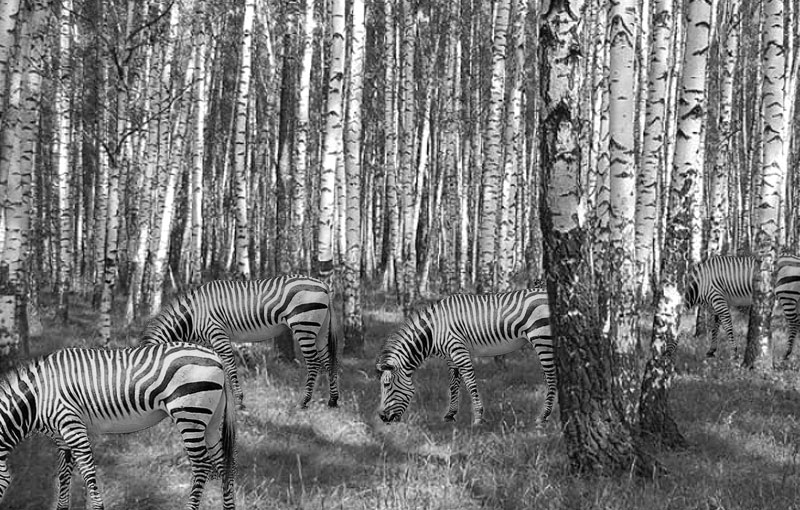when the point arrives that natural interbreeding is not successful, then scientists (not me, and certainly no "shaman") define them as different species. Unlike 2+2=4, this is an interesting statement, and the only one you made on the subject.
So is the definition of species "specimens that do not naturally interbreed" or is it "specimens that cannot produce a viable offspring regardless of conditions"?
Bonus question: Are dogs (insert a picture of a daschund and a dane here) a group of species or a single species?
Background: Dog breeders can produce a desired breed (sometime, and if the desire is within reason) without any mutations helping along, by pure selection. So therefore, while mutations do occur in subspecies differentiation, they are not the mechanism or at least not an essential mechanism.

Scientific Proof
(No it is not a proof of anything. It is another picture of zebras, to show you that I can post pictures too. Come to think of it, it is shopped,-- considering the source).
annalex:
"Unlike 2+2=4, this is an interesting statement, and the only one you made on the subject." Then you have not been paying attention, since I've posted the same or similar comments here innumerable times.
Thanks for finally noticing.
annalex: "So is the definition of species "specimens that do not naturally interbreed" or is it "specimens that cannot produce a viable offspring regardless of conditions"?
Of course, you can look that definition up yourself -- simply type in the words "definition of species" in your address line, and up will pop any number of sites with dictionary and encyclopedia type definitions.
Here is a typical definition from Wikipedia:
"A species is often defined as a group of organisms capable of interbreeding and producing fertile offspring.
While in many cases this definition is adequate, more precise or differing measures are often used, such as similarity of DNA, morphology or ecological niche.
Presence of specific locally adapted traits may further subdivide species into "infraspecific taxa" such as subspecies (and in botany other taxa are used, such as varieties, subvarieties, and formae)."
So my interpretation would be more along the lines of: "sub-species which do not naturally produce viable offspring have become separate species."
For example, horses and donkeys are separate species because their forced off-spring -- mules -- are not viable in nature.
Various sub-species of Zebras -- for examples, Burchell's and Celus Zebras -- are not speparate species because they can and do interbreed in nature.
By contrast, Gevy's Zebra does not naturally interbreed with those others, and when forced (i.e., in a zoo) more often produces offspring which are not viable in nature.
This is clearly evolution "caught in the act" of species differentiation.
Please understand, the ability (or lack of ability) of sub-species to interbreed is not the only factor defining separate species.
That's because this ability (or lack of) normally corresponds to several other factors which confirm the designation of sub-species or species.
Those other factors include DNA analyses showing percentages of differences between one group's genome and another's.
So, the higher the percentage of difference, the less likely are those groups to naturally interbreed, and scientists will therefore consider them separate species.
Where exactly is the DNA dividing line between sub-species and species?
Individual species have different results, and it probably matters just where exactly these DNA mutations show up, but for, say, humans that number is less than 1%, putting for example Neanderthals right on the ragged edge between sub-species and species.
"According to preliminary sequences, 99.7% of the base pairs of the modern human and Neanderthal genomes are identical, compared to humans sharing around 98.8% of base pairs with the chimpanzee.[4]
(Other studies concerning the commonality between chimps and humans have modified the commonality of 98% to a commonality of only 94%, showing that the genetic gap between humans and chimps is bigger than originally thought.)["
annalex: "Bonus question: Are dogs (insert a picture of a daschund and a dane here) a group of species or a single species?"
The separation of dogs from their wolf ancestors was even more recent than the separation of humans from our pre-human ancestors, and so the generation-by-generation buildup of DNA mutations has not been nearly enough to make dogs a separate species from wolves, much less from each other.
Dogs and wolves still interbreed, so by scientific definition, they are still the same species.
annalex: ""therefore, while mutations do occur in subspecies differentiation, they are not the mechanism or at least not an essential mechanism. "
True, but only up to a point.
Consider, for example, the various differences between African elephants and woolly mammouths.
Some of those differences humans could engineer simply by breeding elephants and selecting for cold weather adaptations -- i.e., longer hair, smaller ears.
But other differences could not happen until DNA mutations came along to cause them.
Precisely which changes came from natural selection and which from DNA mutations is a matter for scientific analyses to show.
And the key point to remember is: as DNA mutations build up over many generations, allowing for more and more radical adaptations among separated sub-species, so also does the difficulty of these separated sub-species to interbreed with each other.
In short: the more specialized their adaptations, the more likely they will be unable to interbreed, and thus scientists will classify them as separate species.
annalex: "It is another picture of zebras, to show you that I can post pictures too."
Great work!
The abilities to quickly post photos, links, emphasis, extreme emphasis, bullet points, block quotes and yes, font colors, are all learned skills -- no DNA mutations required ;-) -- skills which improve with practice.
They can add interest and clarity to any post.
